《C++ list 完全指南:list的模拟实现》
《C++ list 完全指南:list的模拟实现》
文章目录
- 《C++ list 完全指南:list的模拟实现》
- 一、定义 list 的成员变量
- 二、list 的接口实现
- (1)list的迭代器实现
- (2)list的默认成员函数
- 2.1 list的构造函数
- 2.2 list的析构函数
- 2.3 list的赋值重载
- 2.4 list的拷贝构造
- (3)list的容量操作实现
- (4)list的访问操作实现
- (5)list的插入和删除
- (6)list的修改操作
- 三、list 源代码总结
- List.h
- Test.cpp
- NewTest.cpp
一、定义 list 的成员变量
list底层就是双向循环链表!

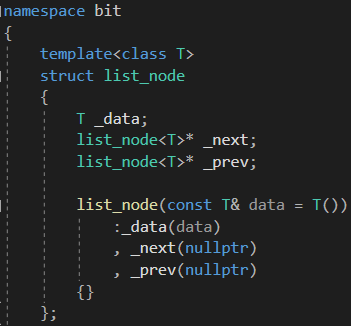
二、list 的接口实现
(1)list的迭代器实现

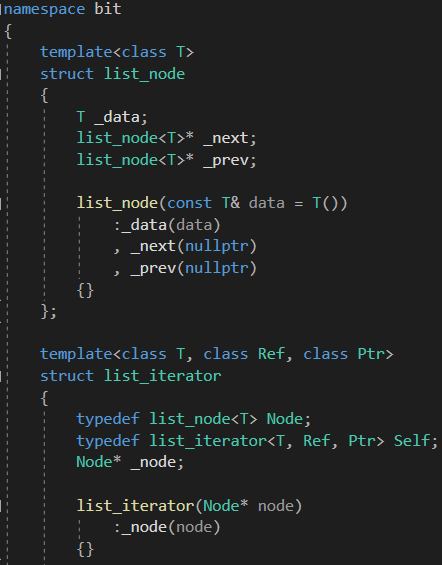
左边是前置++前置- -,右边是后置++后置- -
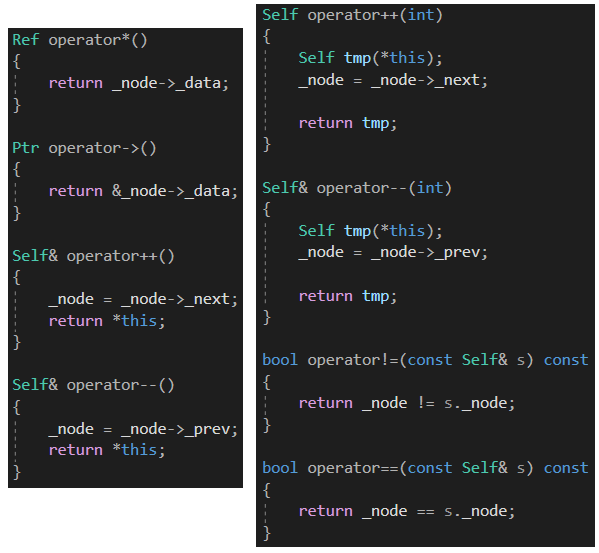
list 中对不同迭代器类型进行typedef简化
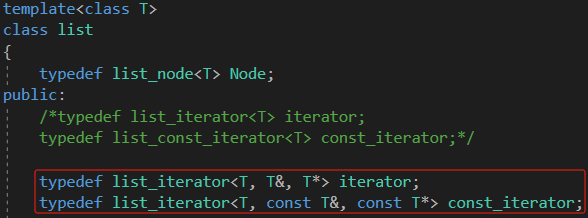
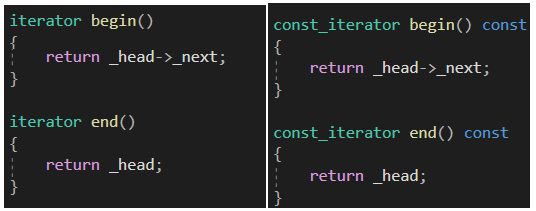
接下来是list的反向迭代器

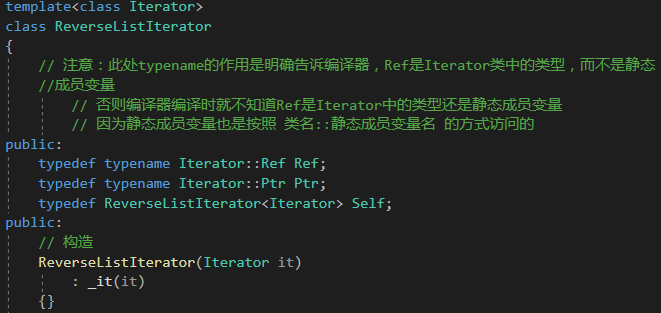
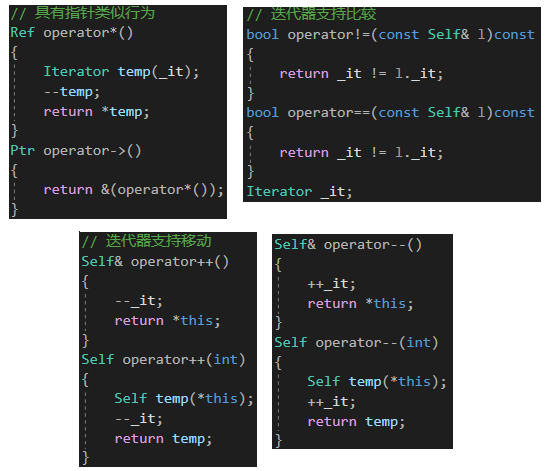
代码如下(示例):
template<class Iterator> class ReverseListIterator{// 注意:此处typename的作用是明确告诉编译器,Ref是Iterator类中的类型,而不是静态//成员变量// 否则编译器编译时就不知道Ref是Iterator中的类型还是静态成员变量// 因为静态成员变量也是按照 类名::静态成员变量名 的方式访问的public:typedef typename Iterator::Ref Ref;typedef typename Iterator::Ptr Ptr;typedef ReverseListIterator<Iterator> Self;public:// 构造ReverseListIterator(Iterator it): _it(it) {}// 具有指针类似行为Ref operator*() {Iterator temp(_it);--temp;return *temp;}Ptr operator->() {return &(operator*());}// 迭代器支持移动Self& operator++() {--_it;return *this;}Self operator++(int) {Self temp(*this);--_it;return temp;}Self& operator--(){++_it;return *this;}Self operator--(int){Self temp(*this);++_it;return temp;}// 迭代器支持比较bool operator!=(const Self& l)const { return _it != l._it; }bool operator==(const Self& l)const { return _it != l._it; }Iterator _it;};
(2)list的默认成员函数
2.1 list的构造函数
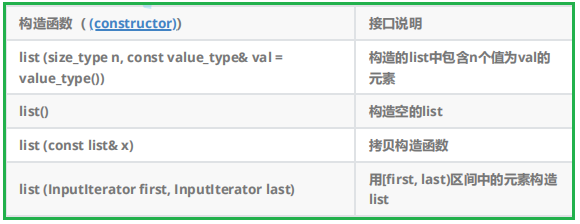
这四种构造函数方式可能会用到empty_init函数
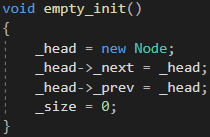
第一种情况:构造的list中包含n个值为val的元素(这里会使用resize)
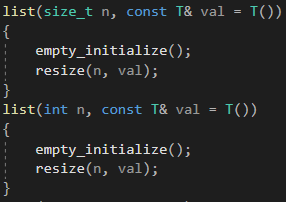
第二种情况:构造空的list

第三种情况:拷贝构造函数
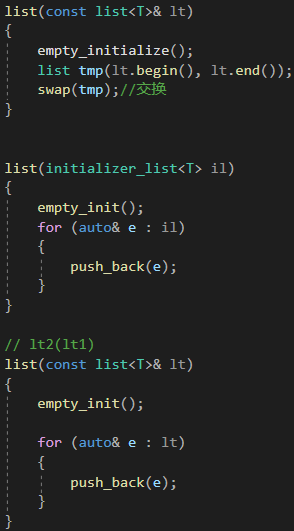
第四种情况:用(first , last)区间中的元素构造list
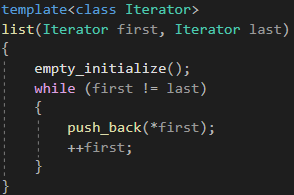
2.2 list的析构函数
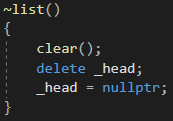
2.3 list的赋值重载
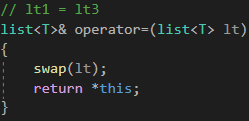
2.4 list的拷贝构造

(3)list的容量操作实现
size( )直接返回有效元素的个数
empty( )判断有效元素个数是否为0
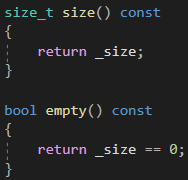
clear( )要清理掉除了头结点以外的所有节点,我们直接用erase删除即可
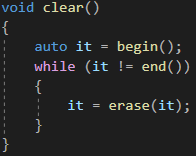
resize和string、vector实现大差不差,这里直接上图

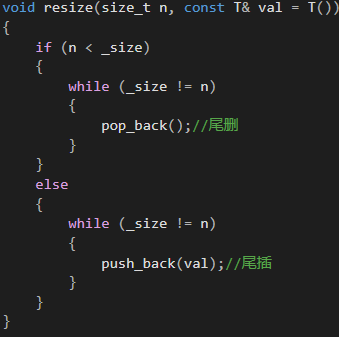
(4)list的访问操作实现
list列表并不支持重载operator[ ],我们只能实现front( )和back( )
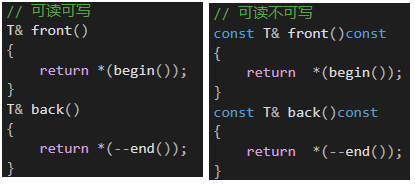
(5)list的插入和删除
在实现insert( )和erase( )两个函数时,要防止迭代器失效
insert( )插入并没有使迭代器失效,为了防止,迭代器应指向新插入的节点
erase( )为了防止迭代器失效,需要返回删除元素的下一个元素的迭代器
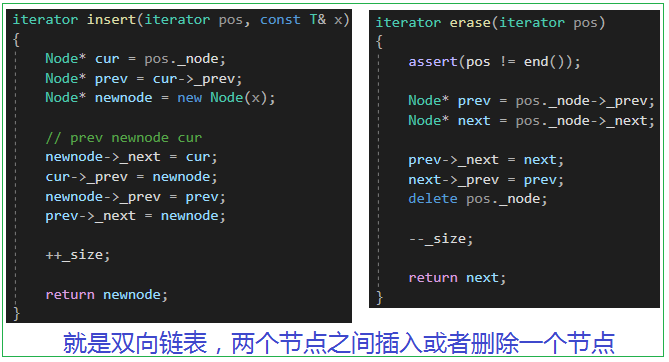
(6)list的修改操作
如果用老方法的话就会显得很复杂,还需要重新插入节点,进行前后的链接!
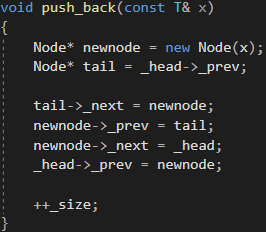
push_back( )和pop_back( )都可以复用 insert( ) 和 earse( )
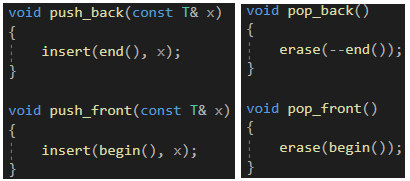
swap( )函数没什么说的,就是将_head 和 _size 进行交换

三、list 源代码总结
List.h
代码如下(示例):
#pragma once
#include<assert.h>namespace bit
{template<class T>struct list_node{T _data;list_node<T>* _next;list_node<T>* _prev;list_node(const T& data = T()):_data(data), _next(nullptr), _prev(nullptr){}};template<class T, class Ref, class Ptr>struct list_iterator{typedef list_node<T> Node;typedef list_iterator<T, Ref, Ptr> Self;Node* _node;list_iterator(Node* node):_node(node){}Ref operator*(){return _node->_data;}Ptr operator->(){return &_node->_data;}Self& operator++(){_node = _node->_next;return *this;}Self& operator--(){_node = _node->_prev;return *this;}Self operator++(int){Self tmp(*this);_node = _node->_next;return tmp;}Self& operator--(int){Self tmp(*this);_node = _node->_prev;return tmp;}bool operator!=(const Self& s) const{return _node != s._node;}bool operator==(const Self& s) const{return _node == s._node;}};/*template<class T>struct list_const_iterator{typedef list_node<T> Node;typedef list_const_iterator<T> Self;Node* _node;list_const_iterator(Node* node):_node(node){}const T& operator*(){return _node->_data;}const T* operator->(){return &_node->_data;}Self& operator++(){_node = _node->_next;return *this;}Self& operator--(){_node = _node->_prev;return *this;}Self operator++(int){Self tmp(*this);_node = _node->_next;return tmp;}Self& operator--(int){Self tmp(*this);_node = _node->_prev;return tmp;}bool operator!=(const Self& s) const{return _node != s._node;}bool operator==(const Self& s) const{return _node == s._node;}};*/template<class T>class list{typedef list_node<T> Node;public:/*typedef list_iterator<T> iterator;typedef list_const_iterator<T> const_iterator;*/typedef list_iterator<T, T&, T*> iterator;typedef list_iterator<T, const T&, const T*> const_iterator;iterator begin(){/* iterator it(_head->_next);return it;*///return iterator(_head->_next);return _head->_next;}iterator end(){return _head;}const_iterator begin() const{return _head->_next;}const_iterator end() const{return _head;}template<class Iterator> class ReverseListIterator{// 注意:此处typename的作用是明确告诉编译器,Ref是Iterator类中的类型,而不是静态//成员变量// 否则编译器编译时就不知道Ref是Iterator中的类型还是静态成员变量// 因为静态成员变量也是按照 类名::静态成员变量名 的方式访问的public:typedef typename Iterator::Ref Ref;typedef typename Iterator::Ptr Ptr;typedef ReverseListIterator<Iterator> Self;public:// 构造ReverseListIterator(Iterator it): _it(it) {}// 具有指针类似行为Ref operator*() {Iterator temp(_it);--temp;return *temp;}Ptr operator->() {return &(operator*());}// 迭代器支持移动Self& operator++() {--_it;return *this;}Self operator++(int) {Self temp(*this);--_it;return temp;}Self& operator--(){++_it;return *this;}Self operator--(int){Self temp(*this);++_it;return temp;}// 迭代器支持比较bool operator!=(const Self& l)const { return _it != l._it; }bool operator==(const Self& l)const { return _it != l._it; }Iterator _it;};void resize(size_t n, const T& val = T()){if (n < _size){while (_size != n){pop_back();//尾删}}else{while (_size != n){push_back(val);//尾插}}}void empty_init(){_head = new Node;_head->_next = _head;_head->_prev = _head;_size = 0;}list(){empty_init();}template<class Iterator>list(Iterator first, Iterator last){empty_initialize();while (first != last){push_back(*first);++first;}}list(size_t n, const T& val = T()){empty_initialize();resize(n, val);}list(int n, const T& val = T()){empty_initialize();resize(n, val);}list(const list<T>& lt){empty_initialize();list tmp(lt.begin(), lt.end());swap(tmp);//交换}list(initializer_list<T> il){empty_init();for (auto& e : il){push_back(e);}}// lt2(lt1)list(const list<T>& lt){empty_init();for (auto& e : lt){push_back(e);}}// lt1 = lt3list<T>& operator=(list<T> lt){swap(lt);return *this;}~list(){clear();delete _head;_head = nullptr;}void clear(){auto it = begin();while (it != end()){it = erase(it);}}// 16:18继续void swap(list<T>& lt){std::swap(_head, lt._head);std::swap(_size, lt._size);}//void push_back(const T& x)//{// Node* newnode = new Node(x);// Node* tail = _head->_prev;// tail->_next = newnode;// newnode->_prev = tail;// newnode->_next = _head;// _head->_prev = newnode;// ++_size;//}void push_back(const T& x){insert(end(), x);}void push_front(const T& x){insert(begin(), x);}iterator insert(iterator pos, const T& x){Node* cur = pos._node;Node* prev = cur->_prev;Node* newnode = new Node(x);// prev newnode curnewnode->_next = cur;cur->_prev = newnode;newnode->_prev = prev;prev->_next = newnode;++_size;return newnode;}void pop_back(){erase(--end());}void pop_front(){erase(begin());}iterator erase(iterator pos){assert(pos != end());Node* prev = pos._node->_prev;Node* next = pos._node->_next;prev->_next = next;next->_prev = prev;delete pos._node;--_size;return next;}// 可读可写T& front(){return *(begin());}T& back(){return *(--end());}// 可读不可写const T& front()const{return *(begin());}const T& back()const{return *(--end());}size_t size() const{return _size;}bool empty() const{return _size == 0;}private:Node* _head;size_t _size;};struct AA{int _a1 = 1;int _a2 = 1;};// 按需实例化// T* const ptr1// const T* ptr2template<class Container>void print_container(const Container& con){// const iterator -> 迭代器本身不能修改// const_iterator -> 指向内容不能修改typename Container::const_iterator it = con.begin();//auto it = con.begin();while (it != con.end()){//*it += 10;cout << *it << " ";++it;}cout << endl;for (auto e : con){cout << e << " ";}cout << endl;}void test_list1(){list<int> lt;lt.push_back(1);lt.push_back(2);lt.push_back(3);lt.push_back(4);list<int>::iterator it = lt.begin();while (it != lt.end()){*it += 10;cout << *it << " ";++it;}cout << endl;for (auto e : lt){cout << e << " ";}cout << endl;print_container(lt);list<AA> lta;lta.push_back(AA());lta.push_back(AA());lta.push_back(AA());lta.push_back(AA());list<AA>::iterator ita = lta.begin();while (ita != lta.end()){//cout << (*ita)._a1 << ":" << (*ita)._a2 << endl;// 特殊处理,本来应该是两个->才合理,为了可读性,省略了一个->cout << ita->_a1 << ":" << ita->_a2 << endl;cout << ita.operator->()->_a1 << ":" << ita.operator->()->_a2 << endl;++ita;}cout << endl;}void test_list2(){list<int> lt;lt.push_back(1);lt.push_back(2);lt.push_back(3);lt.push_back(4);// insert以后迭代器不失效list<int>::iterator it = lt.begin();lt.insert(it, 10);*it += 100;print_container(lt);// erase以后迭代器失效// 删除所有的偶数it = lt.begin();while (it != lt.end()){if (*it % 2 == 0){it = lt.erase(it);}else{++it;}}print_container(lt);}void test_list3(){list<int> lt1;lt1.push_back(1);lt1.push_back(2);lt1.push_back(3);lt1.push_back(4);list<int> lt2(lt1);print_container(lt1);print_container(lt2);list<int> lt3;lt3.push_back(10);lt3.push_back(20);lt3.push_back(30);lt3.push_back(40);lt1 = lt3;print_container(lt1);print_container(lt3);}void func(const list<int>& lt){print_container(lt);}void test_list4(){// 直接构造list<int> lt0({ 1,2,3,4,5,6 });// 隐式类型转换list<int> lt1 = { 1,2,3,4,5,6,7,8 };const list<int>& lt3 = { 1,2,3,4,5,6,7,8 };func(lt0);func({ 1,2,3,4,5,6 });print_container(lt1);//auto il = { 10, 20, 30 };/* initializer_list<int> il = { 10, 20, 30 };cout << typeid(il).name() << endl;cout << sizeof(il) << endl;*/}
}Test.cpp
代码如下(示例):
#include<iostream>
#include<algorithm>
#include<list>
#include<vector>
using namespace std;void test_list1()
{list<int> lt;lt.push_back(1);lt.push_back(2);lt.push_back(3);lt.push_back(4);list<int>::iterator it = lt.begin();while (it != lt.end()){cout << *it << " ";++it;}cout << endl;for (auto e : lt){cout << e << " ";}cout << endl;/*it = lt.begin();lt.erase(it + 3);*/// 不支持,要求随机迭代器//sort(lt.begin(), lt.end());string s("dadawdfadsa");cout << s << endl;sort(s.begin(), s.end());cout << s << endl;
}struct A
{
public:A(int a1 = 1, int a2 = 1):_a1(a1), _a2(a2){cout << "A(int a1 = 1, int a2 = 1)" << endl;}A(const A& aa):_a1(aa._a1), _a2(aa._a2){cout << "A(const A& aa)" << endl;}int _a1;int _a2;
};void test_list2()
{/*list<int> lt;lt.push_back(1);lt.emplace_back(2);lt.emplace_back(3);lt.emplace_back(4);for (auto e : lt){cout << e << " ";}cout << endl;*/list<A> lt;A aa1(1, 1);lt.push_back(aa1);lt.push_back(A(2, 2));//lt.push_back(3, 3);lt.emplace_back(aa1);lt.emplace_back(A(2, 2));cout << endl;// 支持直接传构造A对象的参数emplace_backlt.emplace_back(3, 3);
}void test_list3()
{list<int> lt;lt.push_back(1);lt.push_back(2);lt.push_back(3);lt.push_back(4);lt.push_back(5);lt.push_back(6);for (auto e : lt){cout << e << " ";}cout << endl;auto it = lt.begin();int k = 3;while (k--){++it;}lt.insert(it, 30);for (auto e : lt){cout << e << " ";}cout << endl;int x = 0;cin >> x;it = find(lt.begin(), lt.end(), x);if (it != lt.end()){lt.erase(it);}for (auto e : lt){cout << e << " ";}cout << endl;
}void test_list4()
{list<int> lt;lt.push_back(1);lt.push_back(20);lt.push_back(3);lt.push_back(5);lt.push_back(4);lt.push_back(5);lt.push_back(6);for (auto e : lt){cout << e << " ";}cout << endl;// 升序// lt.sort();// 降序 - 仿函数// less<int> ls;// greater<int> gt;// lt.sort(gt);lt.sort(greater<int>());// lt.reverse();//reverse(lt.begin(), lt.end());for (auto e : lt){cout << e << " ";}cout << endl;std::list<double> first, second;first.push_back(3.1);first.push_back(2.2);first.push_back(2.9);second.push_back(3.7);second.push_back(7.1);second.push_back(1.4);first.sort();second.sort();first.merge(second);
}void test_list5()
{list<int> lt;lt.push_back(1);lt.push_back(20);lt.push_back(3);lt.push_back(5);lt.push_back(5);lt.push_back(4);lt.push_back(5);lt.push_back(6);lt.sort();for (auto e : lt){cout << e << " ";}cout << endl;lt.unique();for (auto e : lt){cout << e << " ";}cout << endl;
}void test_list6()
{// 一个链表节点转移给另一个链表std::list<int> mylist1, mylist2;std::list<int>::iterator it;// set some initial values:for (int i = 1; i <= 4; ++i)mylist1.push_back(i); // mylist1: 1 2 3 4for (int i = 1; i <= 3; ++i)mylist2.push_back(i * 10); // mylist2: 10 20 30it = mylist1.begin();++it; // points to 2mylist1.splice(it, mylist2); // mylist1: 1 10 20 30 2 3 4// mylist2 (empty)// "it" still points to 2 (the 5th element// 调整当前链表节点的顺序list<int> lt;lt.push_back(1);lt.push_back(2);lt.push_back(3);lt.push_back(4);lt.push_back(5);lt.push_back(6);for (auto e : lt){cout << e << " ";}cout << endl;int x = 0;cin >> x;it = find(lt.begin(), lt.end(), x);if (it != lt.end()){//lt.splice(lt.begin(), lt, it);lt.splice(lt.begin(), lt, it, lt.end());}for (auto e : lt){cout << e << " ";}cout << endl;
}void test_op1()
{srand((unsigned int)time(0));const int N = 1000000;list<int> lt1;vector<int> v;for (int i = 0; i < N; ++i){auto e = rand() + i;lt1.push_back(e);v.push_back(e);}int begin1 = clock();// 排序sort(v.begin(), v.end());int end1 = clock();int begin2 = clock();lt1.sort();int end2 = clock();printf("vector sort:%d\n", end1 - begin1);printf("list sort:%d\n", end2 - begin2);
}void test_op2()
{srand(time(0));const int N = 1000000;list<int> lt1;list<int> lt2;for (int i = 0; i < N; ++i){auto e = rand() + i;lt1.push_back(e);lt2.push_back(e);}int begin1 = clock();// 拷贝vectorvector<int> v(lt2.begin(), lt2.end());// 排序sort(v.begin(), v.end());// 拷贝回lt2lt2.assign(v.begin(), v.end());int end1 = clock();int begin2 = clock();lt1.sort();int end2 = clock();printf("list copy vector sort copy list sort:%d\n", end1 - begin1);printf("list sort:%d\n", end2 - begin2);
}#include"List.h"// 10:35
int main()
{//test_list6();//test_op2();bit::test_list4();return 0;
}
NewTest.cpp
代码如下(示例):
//#include <iostream>
//using namespace std;
//#include <forward_list>
//int main()
//{
// forward_list<int> fl = { 1, 2, 3 };
// // 在头部插入元素
// fl.push_front(0);
//
// // 遍历并输出
// for (int num : fl)
// {
// cout << num << " ";
// }
// cout << endl;
//
// return 0;
//}#include <iostream>
#include <list>
using namespace std;
//int main()
//{
// list<int> myList = { 10, 20, 30, 40, 50 };
// // 在头部插入元素
// myList.push_front(5);
// // 在尾部插入元素
// myList.push_back(60);
// // 遍历并输出
// for (int num : myList) {
// cout << num << " ";
// }
// cout << endl;
//
// // 删除指定元素
// myList.remove(30);
//
// // 再次遍历输出
// for (int num : myList) {
// cout << num << " ";
// }
// cout << endl;
// return 0;
//}void Test1()
{// 默认构造函数list<int> numbers1;cout << "默认构造: ";for (const auto& num : numbers1) {cout << num << " ";}cout << endl;// n个val构造list<int> numbers2(5, 10);cout << "n个val构造: ";for (const auto& num : numbers2) {cout << num << " ";}cout << endl;int arr[] = { 1, 2, 3 };// 通过vector的迭代器初始化list<int> numbers3(arr, arr + sizeof(arr) / sizeof(arr[0]));cout << "迭代器区间构造: ";for (const auto& num : numbers3) {cout << num << " ";}cout << endl;list<int> numbers4 = { 4, 5, 6 };// 拷贝构造list<int> numbers5(numbers4);cout << "拷贝构造: ";for (const auto& num : numbers5) {cout << num << " ";}cout << endl;numbers1 = numbers2;// 赋值重载cout << "赋值重载: ";for (const auto& num : numbers1) {cout << num << " ";}cout << endl;
}
void Test2()
{list<int> numbers = { 1, 2, 3, 4, 5 };list<int>::iterator it = numbers.begin();cout << "First element: " << *it << endl;while (it != numbers.end()){cout << *it << " ";++it;}// 注意:这里不能直接解引用it,因为此时它指向的是头节点cout << endl;
}
void Test3()
{list<int> numbers = { 1, 2, 3, 4, 5 };list<int>::reverse_iterator rit = numbers.rbegin();cout << "Last element: " << *rit << endl;while (rit != numbers.rend()){cout << *rit << " ";++rit;}cout << endl;
}
void Test4()
{list<int> numbers = { 1, 2, 3, 4, 5 };cout << "Size of list: " << numbers.size() << endl;cout << "Max size of list: " << numbers.max_size() << endl;
}void Test5()
{list<int> numbers;if (numbers.empty()){cout << "List is empty" << endl;}numbers = { 1, 2, 3 };numbers.clear();if (numbers.empty()){cout << "List is cleared and now empty" << endl;}
}void Test6()
{list<int> numbers = { 1, 2, 3 };numbers.resize(5);cout << "After resizing to 5: ";for (auto& num : numbers){cout << num << " ";}cout << endl;numbers.resize(2);cout << "After resizing to 2: ";for (auto& num : numbers){cout << num << " ";}cout << endl;
}
void Test7()
{list<int> myList = { 10, 20, 30 }; // 创建一个包含元素的列表// 输出列表的第一个元素cout << "The front element is: " << myList.front() << endl;// 输出列表的最后一个元素cout << "The back element is: " << myList.back() << endl;
}void Test8()
{list<int> myList; // 创建一个空列表myList.push_back(10); // 在列表尾部添加元素 10myList.push_back(20); // 在列表尾部添加元素 20cout << "列表元素: ";for (auto& num : myList) {cout << num << " ";}cout << endl;myList.pop_back(); // 删除列表尾部的元素cout << "删除尾部元素后列表元素: ";for (auto& num : myList) {cout << num << " ";}cout << endl;
}
void Test9()
{list<int> myList; // 创建一个空列表myList.push_front(5); // 在列表头部添加元素 5myList.push_front(3); // 在列表头部添加元素 3cout << "列表元素: ";for (auto& num : myList) {cout << num << " ";}cout << endl;myList.pop_front(); // 删除列表头部的元素cout << "删除头部元素后列表元素: ";for (auto& num : myList){cout << num << " ";}cout << endl;
}
void Test10()
{list<int> myList = { 1, 2, 3 };list<int>::iterator it = myList.begin();it = myList.insert(it, 4); // 这里迭代器 it 失效it = myList.insert(it, 5); // 这里迭代器 it 失效for (auto& num : myList){cout << num << " ";}cout << endl;
}
void Test11()
{list<int> myList = { 1, 2, 3, 4, 5 };list<int>::iterator it = myList.begin();it = myList.erase(it); // 迭代器 it 失效it = myList.erase(it); // 迭代器 it 失效for (auto& num : myList){cout << num << " ";}cout << endl;
}
void Test12()
{list<int> list1 = { 1, 2, 3 };list<int> list2 = { 4, 5, 6 };cout << "交换之前:" << endl;for (auto& num : list1){cout << num << " ";}cout << endl;for (auto& num : list2){cout << num << " ";}cout << endl;list1.swap(list2);cout << "交换之前:" << endl;for (auto& num : list1){cout << num << " ";}cout << endl;for (auto& num : list2){cout << num << " ";}cout << endl;}
void Test13()
{list<int> list1 = { 1, 2, 3 };list<int> list2 = { 4, 5 };// 将 list2 的元素转移到 list1 中list1.splice(list1.end(), list2);for (auto num : list1) {cout << num << " ";}cout << endl;
}
void Test14()
{list<int> myList = { 1, 2, 2, 3, 2 };// 移除值为 2 的元素myList.remove(2);for (auto num : myList) {cout << num << " ";}cout << endl;
}
bool isEven(int num) {return num % 2 == 0;
}void Test15() {list<int> myList = { 1, 2, 3, 4, 5, 6 };// 移除满足偶数条件的元素myList.remove_if(isEven);for (auto num : myList) {cout << num << " ";}cout << endl;
}
void Test16()
{list<int> myList = { 1, 2, 2, 3, 3, 3 };// 移除相邻的重复元素myList.unique();for (auto num : myList) {cout << num << " ";}cout << endl;
}
void Test17()
{list<int> list1 = { 1, 3, 5 };list<int> list2 = { 2, 4, 6 };list1.sort();list2.sort();// 合并两个已排序的列表list1.merge(list2);for (auto num : list1) {cout << num << " ";}cout << endl;
}
void Test18() {list<int> myList = { 3, 1, 4, 1, 5, 9, 2, 6, 5 };// 对列表进行排序myList.sort();for (auto num : myList) {cout << num << " ";}cout << endl;
}
void Test19()
{list<int> l2 = { 1,2,4,5 };l2.reverse();//list中的reversereverse(l2.begin(), l2.end());//算法库中的reversefor (auto& num : l2){cout << num << " ";}
}
void TestListIterator1()
{int array[] = { 1, 2, 3, 4, 5, 6, 7, 8, 9, 0 };list<int> l(array, array + sizeof(array) / sizeof(array[0]));auto it = l.begin();while (it != l.end()){// erase()函数执行后,it所指向的节点已被删除,因此it无效,在下一次使用it时,必须先给//其赋值l.erase(it);++it;}
}
// 改正
void TestListIterator()
{int array[] = { 1, 2, 3, 4, 5, 6, 7, 8, 9, 0 };list<int> l(array, array + sizeof(array) / sizeof(array[0]));auto it = l.begin();while (it != l.end()){l.erase(it++); // it = l.erase(it);}
}int main()
{//Test1();//Test2();//Test4();//Test5();//Test6();//Test7();//Test8();//Test9();//Test10();//Test11();//Test12();//Test13();//Test14();//Test15();//Test16();//Test17();//Test18();Test19();
}
